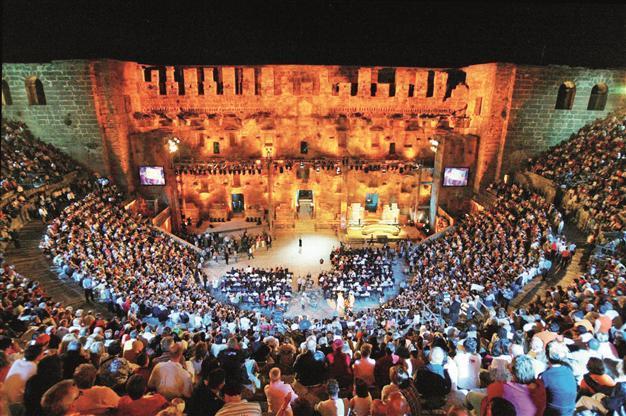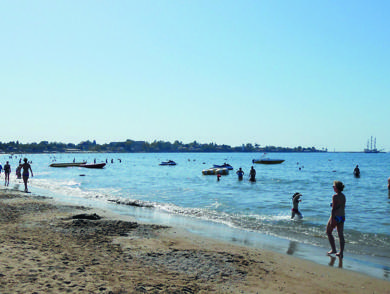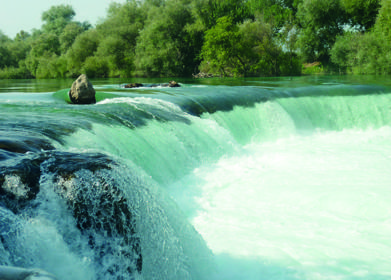Ancient Side beckons on Turkey’s Mediterranean
Nina Chestney Reuters

Side, a peninsula just one-kilometer-long and 400 meters wide, is one of the most famous classical sites in Turkey.
After thousands of years of settlement by newcomers ranging from the ancient Greeks, Romans and Persians, to pirates, Arabs and Jews, Side on Turkey’s Mediterranean coast is used to visitors.Side is located on Turkey’s southeast coast, around 70 km from the city of Antalya, a popular and developed tourist resort. A peninsula just one-kilometer-long and 400 meters wide, Side is one of the most famous classical sites in Turkey. It is believed to have been founded by Greek settlers in the 7th century B.C. and its harbor and geography made it an attractive trade center for other occupiers, including Alexander the Great, Sicilian pirates and the Romans.
In the 7th century A.D., Arabs raided and burned Side, beginning its slow decline. Then in 1895, Turkish Muslim refugees from Crete arrived and the revival began.
Here are tips for getting the most out of Side.
Exploring the ruins:
At the end of the road leading to the Old Town (Antik Side), an amphitheater on the left was built in the Roman style because Side did not have a suitable hillside that could be hollowed out in the usual Greek way.
Not as well-preserved as the one in the nearby Aspendos, it still can seat up to 20,000 people and hosts jazz festivals, opera, and classical concerts during the summer months.
Toward the Hellenistic main gate of the ancient city, you can stroll through the ruins of homes and shops, some of which still have their original mosaic floors.
Through the gate of the ancient city you come to a street flanked by colonnades. The remains of a Roman bath are here, now a museum displaying Roman statues.
At the eastern edge of the peninsula, past the harbor to the left, stand the remains of the 2,000-year-old Temple of Apollo, at their most majestic at sunset. The Turkish government has been restoring the temple’s columns, which had been eroded by saltwater.
Getting around:
The best way to explore Side is on foot. Its back streets hide small mosques, boutique hotels, quirky cottages and olive gardens.
At Side harbor, you can take boat trips to Antalya, Manavgat or go on the trail of dolphins, which, if you are lucky, can be spotted off the peninsula. On land, minibuses are a frequent, cheap and often an entertaining way to get around.
 Sun, sea, set sail:
Sun, sea, set sail: Side has long, hot summers and short, mild winters. In the peak season – July and August – temperatures can reach 40 degrees Celsius or higher. Spring and autumn are more comfortable times to visit, with temperatures in the 20s and 30s, with maybe the odd thunderstorm and rain.
Sun worshippers have plenty of choices with stretches of beach on both the east and west sides of the peninsula.
The west side was renovated around five years ago with a restaurant-lined promenade and five-star hotels. The sea here is shallower and therefore more popular with some tourists.
The east side is less crowded and attracts more locals, especially on Sundays. Lined with beach bars, it has a more relaxed feel. There the beach is wider, a bit rockier and the sea is slightly deeper, great for watersports and parasailing.
Shop till you drop:
The center of Side is the place for leather goods, hand-woven rugs, pottery, designer handbags, jewelry, watches and sportswear – but be prepared to haggle and explore the side streets for the best deals.
Manavgat, a working town just north of Side, might not be as glamorous, but has plentiful and cheap markets twice a week, as well as plenty of sportswear and clothing stores. This is the place to experience the juiciest of strawberries, cherries, melons and figs – at pleasingly low prices.
Eating and drinking:
For cheap snacks, sample fresh corn cobs, or try a durum, a wrap filled with typical döner kebab ingredients.
For only a few Turkish Liras, you can pick up the Turkish version of a pizza, called lahmacun, an oval, thin dough topped with minced meat, herbs and tomatoes.
 Explore:
Explore: Just three kilometers north of Manavgat are the waterfalls on the Manavgat River. Boat trips reach here from the Manavgat town, but you can also drive to the Oymapınar Dam, a thundering tower of water.
Nearby is the Green Lake, named for the color of the water. This is a peaceful spot to escape the heat. Restaurants are signposted where you can eat by the lakeside and swim from floating jetties.
Aspendos lies between Side and Antalya with the best-preserved Greek amphitheater. Further south, the ruins of Perge include an acropolis dating back to the Bronze Age.
South of Antalya and inland, Pamukkale, or “cotton castle” in Turkish, looks just that. A World Heritage site, hot springs pop out of vast terraces of carbonated minerals, which were produced over thousands of years by flowing water.
















